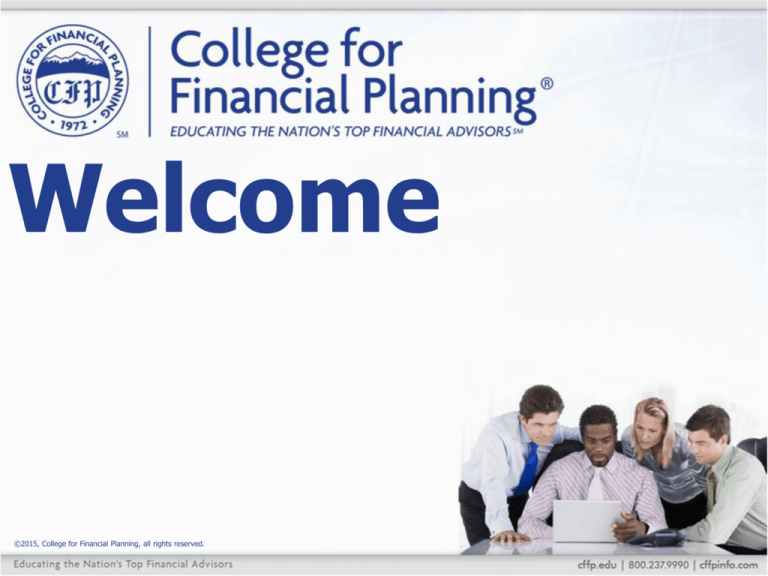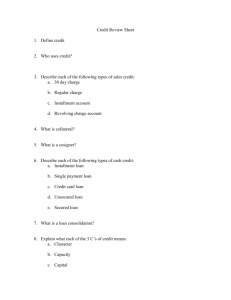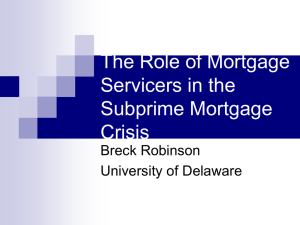
Welcome
©2015, College for Financial Planning, all rights reserved.
Expectations of Students
•
•
•
•
Time/energy commitment
Read assignments before class
Tested on all LOs
This course will enable you to:
o be eligible to sit for the
CFP® Certification
Examination
o better serve clients/
grow your business
o be successful on the
College’s end-ofcourse examination
1-2
For Optimal Performance
The quality of your Internet-streamed session depends on
your connection:
Reboot your PC before each session to refresh
memory.
Directly connect to the Internet. Delete cookies and
temporary Internet files each week.
Close other programs while attending your live
online class.
Before each session, in your live class, go to Meeting then
Audio Setup Wizard to adjust your settings.
These steps resolve 90% of issues.
1-3
Housekeeping Items
1. Professor contact information
2.3.
4.
5.6.
7.
in eCampus
Tutorial in Lobby
Status changes
Text chat
Files for students
Recordings
Access Poll Layout
1-4
CERTIFIED FINANCIAL PLANNER CERTIFICATION
PROFESSIONAL EDUCATION PROGRAM
Financial Planning Process & Insurance
Session 1
Steps of the Planning
Process
Financial Statements
Debt Management
©2015, College for Financial Planning, all rights reserved.
© 2012, College for Financial Planning, all rights reserved.
Session Details
Module
1
Chapter(s) 1
LOs
1-1
Explain the what and why of the steps in the
financial planning process.
1-6
Six Steps in the Financial Planning Process
Step 1: Establishing and Defining the Client-Planner Relationship
(Practice Standards (PS) 100-1)
Step 2: Gathering Client Data Including Goals (PS 200-1 and 2)
Step 3: Analyzing and Evaluating the Client’s Financial Status (PS 300-1)
Step 4: Developing and Presenting Financial Planning Recommendations
and/or Alternatives (PS 400 1, 2, and 3)
Step 5: Implementing the Financial Planning Recommendations (PS 500)
Step 6: Monitoring the Financial
Planning Recommendations
(PS 600-1)
1-7
Remembering the Six Steps
Establish
Gather
Analyze
Develop
Implement
Monitor
EGAD I Made it!
1-8
Session Details
Module
1
Chapter(s) 2
LOs
1-3
Construct and interpret personal financial
statements.
1-9
Personal Financial Statements
Statement of Financial
Position
• Assets and liabilities
• Net worth
Cash Flow Statement
• Inflows and outflows
Remember
• Financial activity may show
up in various places on
different financial statements
• Pay attention to the footnotes
1-10
Statement of Financial Position as of [date]
Assets1
Cash/Cash Equivalents
Invested Assets
After Tax
Tax Advantaged
Qualified Plans
Use Assets
Total Assets
Liabilities &
Net Worth
Liabilities2
Net Worth
Total Liabilities
& Net Worth
1
Presented at fair market value
2
Principal only
1-11
Cash Flow Statement Year Ending [date]
Inflows
Gross Salaries
Dividend Income1
Interest Income
Other Income
Total Inflows
Outflows
Savings and Investments2
Fixed Outflows
Variable Outflows
Total Outflows
1
Stock portfolio
2
IRA, 401k and growth mutual fund (if employer match included, show as income also)
Note: Some statements may include a final category that identifies either a client's net
surplus or a net deficit.
1-12
Financial Position or Cash Flow?
Examples that may be useful in figuring out where an
amount should be included or eliminated when
answering a question might include the following:
Statement of Financial Position:
Cash Flow Statement:
IRA Balance
IRA Contribution
Statement of Financial Position:
Cash Flow Statement:
Auto Loan Balance
Auto Loan Payment
Statement of Financial Position:
Cash Flow Statement:
Portfolio Value
Portfolio Income
Statement of Financial Position:
Cash Flow Statement:
Net Worth
Net Inflow (Outflow)
1-13
Session Details
Module
1
Chapter(s) 3 & 5
LOs
1-6
Explain different forms of debt and their uses.
1-14
Debt Management & Financial Ratios
• Debt-to-Income Ratio (front-end ratio):
o monthly housing (PITI) should be no more than
28% of gross income including HOA fees, etc.
• Total Monthly Payments (back-end ratio):
o no more than 36% of gross income
o includes all debt
• Total Consumer Debt
(non-mortgage
debt-to-income ratio):
o no more than 20% of net income
1-15
Types of Mortgages: Government Guaranteed
GNMA
• Government National Mortgage Association
• U.S. government agency fully guaranteeing the
mortgage
FHA
• Federal Housing Administration offers low interest
loans, backed by the U.S. government
• FHA sets maximum allowable interest rates, limit of
insurance, and loan term
VA
• Guaranteed by the Department of Veterans Affairs in
the event of a loan default
• Honorably discharged veterans of the U.S. armed
forces are eligible
• VA sets maximum amount of guarantees, interest
rates, and maturities
1-16
Types of Mortgages: Lenders & Guarantors
FNMA
• Federal National Mortgage Association (Fannie Mae)
• Not government guaranteed, but federally chartered
• Implicitly taxpayer-backed with lower rates available
FHLMC
• Federal Home Loan Mortgage Corp. (Freddie Mac)
• Similar to FNMA; implicitly taxpayer-backed, but not
government guaranteed
• Low-cost loans available with government help
Conventional
• Involves only lender and borrower
• Between 35% and 50% of these meet FNMA or
FHLMC funding criteria
• There is no outside agency guaranteeing or insuring
the mortgage
1-17
Types of Mortgages: Interest
Fixed
Rate
• Monthly payments are fixed at the
outset of the loan and remain the
same over the term of the loan
• Term of the loan typically is from
15 to 30 years
Variable
Rate
• Adjustable rate mortgage (ARM)
• Interest rate on the mortgage may
change periodically, increasing or
decreasing the payment amount
1-18
Types of Mortgages: Payments & Payoffs
Monthly
• Payments are made once monthly
Bi-weekly
• Payment every two weeks
• Results in one additional payment annually
Graduated
• Payments increase over the loan term
• May create reverse amortization – even owing more than
residence is worth
Interest
Only
• Payments consist of interest only for a set period, ultimately
changing to PITI
Balloon
• Low monthly mortgage payments for a limited period of time with
a large (balloon) payment at end of the term
Reverse
• Individuals, age 62 or over, use their home equity for living
expenses
• Amounts received must be repaid when owner leaves home
1-19
Question 1
Paul King, a CFP® certificant, is ready to have his
clients, Nick and Faith, implement their financial plan.
Which one of the following is most appropriate at this
stage of the financial planning process?
a. Paul will prepare a list of the professionals he has
specified to prepare the necessary documents.
b. Paul will hand the plan to Nick and Faith and tell
them to contact him if they have any questions
regarding the implementation process outlined in the
plan.
c. Paul will guide Nick and Faith through the steps
required to put the plan in motion.
d. Paul will establish priorities for Nick and Faith,
clearly mapping out the order in which each facet of
the plan is to be implemented.
1-20
Question 2
Which of the following items are normally
included in a statement of financial position?
I. dividend income
II. money market account balance
III. mortgage note balance
IV. vested pension benefits
a. I only
b. I and IV only
c. II and III only
d. II, III, and IV only
1-21
Question 3
When discussing a mortgage on a client’s
personal residence, the concept of leverage
explains which one of the following?
a. the ability to convince the lender to make
the loan
b. the deductibility of the mortgage payment
when calculating income taxes
c. the ability to have a 20% gain when the
value of the home increases by 4%
d. the ability to borrow 95% of the value of the
home
1-22
CERTIFIED FINANCIAL PLANNER CERTIFICATION
PROFESSIONAL EDUCATION PROGRAM
Financial Planning Process & Insurance
Session 1
End of Slides
©2015, College for Financial Planning, all rights reserved.








